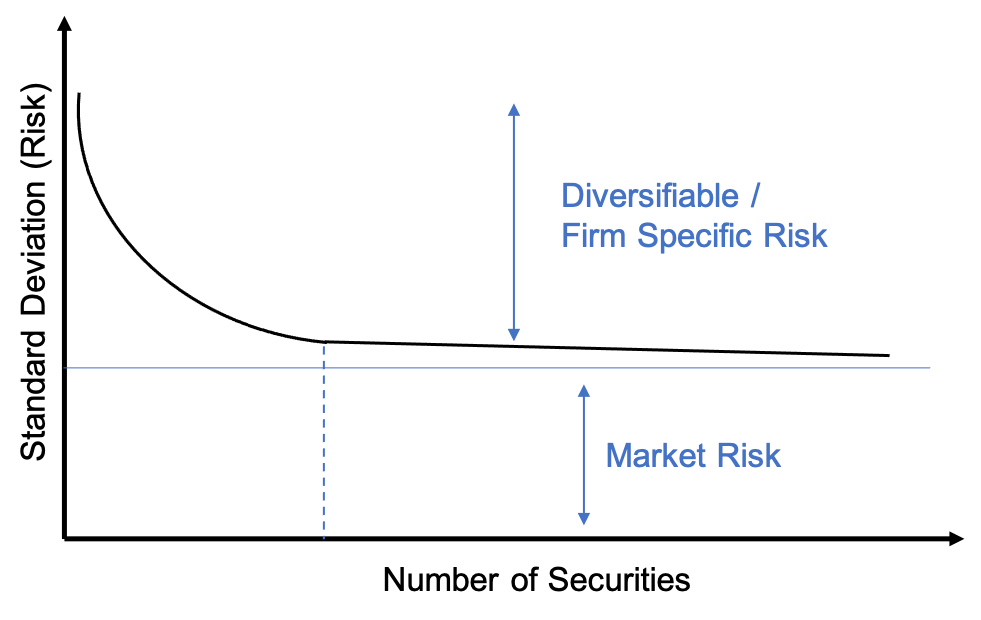Diversification and Portfolio Risk
Diversification is a cardinal rule when investing in securities, to reduce risk. Investors are advised to diversify their portfolio in order to reduce risk but without compromising much on the returns of the portfolio.
Just how much should an investor diversify to mitigate risk? We can use a graph to understand this. We can plot the riskiness of the portfolio by using the standard deviation (volatility of returns) on the y-axis and the number of stocks in the portfolio on the x-axis. You will notice that as the number of securities in the portfolio increases, theoverall risk keeps reducing. However, this reduction happens upto a point and after that adding more securities to the portfolio doesn’t further reduce the risk. Many experts suggest that this point where the risk stops reducing further is at somewhere having 20 to 50 different types of securities in a portfolio, however, this number may vary. The portfolio can be a mix of bonds and stocks from very different industries - oil and gas, banking, software and gold etc.

Diversifiable Risk
You will notice that the risk reduces upto a point but is not eliminated completely. This is because we still have other risk factors that can impact the portfolio. The risk cannot be eliminated completely. The risk that can be eliminated by diversification is referred to as non-diversifiable risk, or firm-specific risk.
Let’s say you have invested all your money in one company’s stock, let’s say, Tesla. In that case, you have only one stock in your portfolio and there is no diversification. When that happens, your portfolio return’s are completely tied to Tesla’s stock and if Tesla’s stock crashes for some reason, your investment will crash too. On the other hand, if your portfolio was well diversified, no one company’s movement could adversely impact the portfolio. By diversifying, we reduce the exposure to risk to any one stock.
Non-diversifiable Risk
Non-diversifiable risk on the hand is the risk that cannot be eliminated even if our portfolio is well diversified. This type of risk is called market risk. It comes from external factors like a war, climate crisis or any other market factor that will impact the market and your portfolio no matter what.
An economic recession is an example of non-diversifiable risk that impacts the entire portfolio. It is a sort of built-in risk.
So the total risk of the portfolio is the sum of diversifiable risk or firm specific risk and non-diversifiable risk. When we own a less diversified portfolio, we have to worry about total risk. If we have a well diversified portfolio we diminish the role of firm risk and we have to focus more on market risk. There are different ways to measure market risk and adopt methods to reduce it.
Portfolio Risk
Let us take a look at the different types of portfolio risk:
-
Market risk: This risk arises due to market volatility. It can be due to change in currency rates, a dip in the stock market, an increase or decrease in interest rates or a change in the price of commodities. Read more about Market Risk.
-
Liquidity risk: Liquidity risk comes from the inability to sell your security in the market. For example, gold is considered highly liquid as you can easily sell it, however, real-estate is an illiquid investment, and it’s not very easy to sell.
-
Concentration risk: An investor who puts most or all of their money in one type of asset class is increasing the risk on their portfolio. This is known as concentration risk
-
Credit risk: Investment instruments like bonds face the risk of companies not being able to fulfill their interest or redemption ( where applicable) commitments. This is known as credit risk. One way of mitigating credit risk is that you must look at the company’s credit ratings.
-
Reinvestment risk: Investors in bonds face reinvestment risk. The risk arises from the fact that the investor may have to invest the interim cash flows from the bonds at a lower interest rate (if interest rates have fallen) than what they earn from the security.
-
Horizon risk: An asset bought with the intent of being held long, may have to be liquidated due to some event. This may happen when market returns are low. This risk is known as horizon risk.
How is portfolio risk and return calculated?
Portfolio risk can be measured by using the standard deviation of variance of actual returns of a portfolio over a period of time.
Portfolio return is calculated by adding the weighted average of the returns from the assets in the portfolio.
Learn how to calculate portfolio risk and return.
Risk Return Tradeoff
There is always a risk and return tradeoff while investing. Though equities are high in risk, since market volatility affects them, they also usually provide the highest rate of returns.
An investor’s tolerance for risk, the investment horizon, and the potential for reinvestment determine the risk return tradeoff. Investment decisions like concentration of assets, what mix of assets, etc., determine the best risk return tradeoff.
Investors may choose to invest in some high risk equities and some stable but low return equities, or commodities. This ensures they have a balanced portfolio.


